This Day in History
Historic Fun FactsThis Day in History, November
November 2, 1852
On this day in 1852, Sacramento’s great fire, known as the Great Conflagration, burned more than 80 percent of the structures in the city. The structures were mainly made of canvas and wood. It is estimated that the total damages from the fire was around six million dollars. The fire started at the millinery shop of Madame Lanas on J and 4th Street. Within a month, 761 structures were re-built, many of them in brick; many installed with iron shutters to help prevent fire-wind fanning. The Lady Adams building is the only original building in Old Sacramento to survive the fire.
November 3, 1844
On this day in 1844, Alta California Governor Manuel Micheltorena deeded Rancho Cosumnes to William Edward Petty Hartnell. The land grant was originally 11 square leagues of land (about 48,000 acres) but was later reduced to 6 leagues by the U.S. Lands Commission in the mid-1850s because his previous Rancho Todos Santos y San Antonio in Santa Barbara County was 5 leagues. Eleven square leagues was the maximum one individual could own under Mexican law.
Rancho Cosumnes bordered the south side of the Cosumnes River, opposite from Jared Sheldon’s Rancho Omochumnes, in what is today the town of Wilton. Hartnell came to California in 1822 and served in a variety of government jobs in Monterey through the early 1840s. During the Mexican-American War, he translated all Mexican laws into English for John C. Fremont. Hartnell was a delegate at the California Constitutional Convention in 1849 and translated the Constitution into Spanish and helped ensure California was a bilingual state.
November 4, 1841
On this day in 1841, the Bidwell-Bartleson Party arrived at Dr. John Marsh’s rancho at the foot of Mount Diablo. The wagon party departed Westport, Missouri in mid-May 1841 and finally made it to California within 6 months traveling around 15 miles a day. They are known to history as the first wagon party to travel overland to California. John Bidwell, a 22 year old schoolteacher and president of the Western Emigration Society was the leader of the group. The wagon party journeyed, initially, with several Jesuit priests and other emigrants bound for Oregon.
At Soda Springs, just south of Fort Hall, the 34 members of the Bidwell-Bartleson Party separated from the other emigrants and headed for California with only vague directions. The group abandoned their wagons long before the Sierra Nevada because there was no established trail for their wagons. They ate their oxen approaching the Sierra, their horses and mules crossing the Sierra at the Sonora Pass, and their dogs on their way down from the mountains into California. When they arrived at Dr. Marsh’s rancho, they were exhausted and famished but Marsh, reluctantly, welcomed them into his home. Marsh sent the group to the Mission San Jose to obtain passports only for them to be thrown in jail for being undocumented Americans in Alta California. Marsh vouched on their behalf charging 5 dollars per person in order for them to get passports, even though the passports didn’t cost anything to regularly obtain. Because of Marsh’s treatment, they journeyed to Sutter’s Fort the next month.
John Bidwell was hired by John Sutter as his clerk and became one of his most-trusted employees. He served during the Mexican-American War and later became the founder of the city of Chico, elected to Congress in 1864, and ran for president in 1892. Of the other 33 members of the wagon party, Nancy Kelsey was the only woman and was pregnant and carrying her two year old child when she arrived at Sutter’s Fort. She was the first American woman to cross the Sierra. Other notable party members include Charles Weber (the founder of the city of Stockton), Josiah Beldon (a later wealthy merchant and the first American elected mayor of San Jose), Heinrich Huber (a distiller and beer maker at the Fort and made some of the first beer in the Sacramento Valley), and Andrew Kelsey (established a rancho in Lake County where Kelseyville is today).
November 5, 1841
On this day in 1841, the Workman-Rowland Party arrived at the Mission San Gabriel after traveling 1,200 miles via the Old Spanish Trail in 2 months from Santa Fe, New Mexico. William Workman and John Rowland formed the party of 40 Anglos and 25 New Mexicans in September 1841. Many of the members joined the wagon party after the war in Texas. Workman and Rowland jointly obtained the La Puente Land Grant in what is now East Los Angeles, upon their arrival to California.
Other members moved to the Sacramento Valley upon hearing that John Sutter was building an establishment near the confluence of the Sacramento and American Rivers. William Knight, and his wife Carmel Lucero, had a small cattle ranch by 1843, where the town of Knight’s Landing is today. William and Carmel Knight were responsible for bringing news to Americans around Sutter’s Fort that the Mexican government was planning to round up government horses to be used by the cavalry to deport undocumented Americans from California in the spring of 1846. This set in motion a series of events that led to the Bear Flag Revolt.
November 6, 1849
On this day in 1849, the steamship Senator began operating between Sacramento City and San Francisco. The steamer, initially, arrived in San Francisco on October 27th from Boston by way around Cape Horn. The Senator arrived in Sacramento City on November 5th and was immediately put into operation. It made its first voyage from Sacramento to San Francisco in 9 hours and set a record for travel. The rates of fare were $25 per person to travel up the river from San Francisco and $30 for travel down the river from Sacramento City. Freight per ton was between $40 and $50. In the first year of operation, the steamer netted a profit of $60,000 per month.
November 11, 1918
On this day in 1918, Armistice was signed in France, ending hostilities in the First World War. Although the Armistice halted the conflict, it took another seven months to negotiate and sign the Treaty of Versailles, which officially ended the Great War. More than 150,000 Californians served during the war. Sacramento played a pivotal role during the war. Aviation was new to warfare and many combat units were trained at Mather Field. Local farmers stepped up production and implemented new farming practices to provide food oversees for the war effort.
November 13, 1849
On this day in 1849, voters approved California’s first Constitution and Peter Hardeman Burnett became California’s first elected governor. The other candidates for governor included Winfield Sherwood, John W. Geary, William M. Steuart, and John A. Sutter.
Peter Burnett was born in Tennessee on November 15, 1807. He moved to Missouri in the early 1830s where he became a lawyer. Because of debts from a failed business, he and his family traveled to Oregon in 1843 as part of the “Great Migration” with roughly 1,000 other people in a wagon train. He served on the legislature in Oregon and helped push for enacting a law to restrict people of African descent from living in Oregon. The law was later overturned, and Burnett later became a judge for the Supreme Court in the Oregon Territory. Hearing of the gold discovery, Burnett came to California in November 1848. The next month, Burnett was hired by John Sutter Jr. to help settle his father’s debts. Burnett helped Sutter Jr. sell city lots in the newly established Sacramento City. He acquired more than 100 city lots as payment for his services. Burnett moved to San Francisco in June 1849.
He was sworn in as the governor on December 20, 1849 in San Jose, California’s capital at the time, in front of the new Legislature. Burnett helped create many aspects of state government that still exist today and appointed William M. Gwin and John C. Fremont to the U.S. Senate. Burnett’s legacy as the governor, however, is wrought with controversy. He supported excluding African Americans and Chinese immigrants from coming to California, signed into law acts that restricted rights of California Indians, and ordered state militia attacks on Native tribes. He resigned from office on January 9, 1851 after being ridiculed for demanding exclusion laws against African Americans and promoting capital punishment for robbery. He was criticized by newspapers for being ineffective but was appointed in 1857 to the California Supreme Court by Governor J. Neely Johnson but resigned a year later. In 1880, Burnett published an autobiography called Recollections and Opinions of an Old Pioneer. Burnett passed away in 1895.
This Day in History, October
October 1, 1907
The Pacific Fruit Express (PFE), formed by the Southern Pacific and Union Pacific Railroad companies, began operation with a fleet of 6,600 refrigerator cars built by the American Car and Foundry Company. The same year, the PFE purchased all Armour Lines owned ice making facilities in California and in 1908 the company built a giant ice making and car icing facility in Roseville. Ice was stored on each end of the train cars. In 1908, its first full year of operation, the PFE transported 40,000 carloads of fruit, vegetables, and other perishable foods from California to eastern states.
October 5, 1846
While the Donner Party was at Pauta Pass, at present-day Golconda, Nevada, a dispute took place over the entanglement of oxen teams for a wagon belonging to the Graves family and of a wagon, led by Milt Elliot, belonging to the Reed family. James Reed interfered between Milt Elliot and John Snyder, a teamster for the Graves family. Snyder hit Reed in the face with a whip and Reed retaliated by stabbing Snyder in the chest. Snyder whipped James and Margaret Reed before dying 15 minutes later. Drama ensued as members of the Donner Party decided the fate of James Reed. Louis Keseberg offered the tongue of his wagon to be used to hang Reed. William Eddy, however, convinced many to allow Reed to be banished from the Donner Party and to travel the rest of the journey to Sutter’s Fort alone.
The banishment of James Reed was a controversial topic amongst the survivors of the Donner Party. Some claimed the killing was in self-defense while others thought that James Reed got away with murder. It was still a controversial topic decades later when survivors of the Donner Party were interviewed by local newspapers and historians to share their fateful experience traveling to California. James Reed arrived at Sutter’s Fort at the end of October while his family and the rest of the Donner Party only reached Truckee Lake near the summit of the Sierra.
October 8, 1810
On this day in 1810, James Wilson Marshall was born in New Jersey. He learned his father’s trade and became a skilled carpenter. Marshall traveled to Oregon in 1844. Unsatisfied with life in Oregon, Marshall travelled south via the Siskiyou trail from Oregon with the McMahon-Clyman Party and arrived at Sutter’s Fort in July 1845. John Sutter immediately hired Marshall.
John Bidwell, Sutter’s head clerk, said Marshall was “ingenious at almost everything.” Marshall built a variety of tools, carts, looms, spinning wheels, furniture, and structures at Sutter’s Fort. After serving in the Mexican-American War, he returned to the Fort and made an agreement with Sutter to build a sawmill off the south fork of the American River in what is today Coloma.
James Marshall discovered gold at the nearly completed sawmill on January 24, 1848 and shared the news with John Sutter four days later when he arrived at the Fort. Just as the Gold Rush ruined Sutter’s business enterprises, it also ruined Marshall. He never received any profits from the sawmill. Marshall worked at the mill until he was driven out of town for defending the local Indians while gold miners wanted them gone. He returned to Coloma in 1850 to find lawsuits filed against for overdue accounts. He had to sell his ranch in Butte County to pay his creditors. Marshall tried his hand at gold mining elsewhere but everywhere he went, miners followed him thinking Marshall had a magic skill for finding gold. When Marshall didn’t find much the miners threatened him.
Marshall tried a hand at growing wine grapes, making furniture, and even giving speeches about the gold discovery to make a living. He spent his last years living in Kelsey, a town near Coloma, as a blacksmith. On August 10, 1885, Marshall passed away in his cabin. A public auction was held, and his belongings were sold to cover his funeral. Andrew Monroe dug a grave for him on the hilltop in Coloma overlooking the site of Marshall’s sawmill. The Native Sons of the Golden West placed a monument on Marshall’s grave in 1890.
October 9, 1846
With James Reed banished from the Donner Party, the Reed family could not keep up with the rest of the group with their over-sized wagon, known to history as the “Pioneer Palace Car.” Milt Elliot, a teamster for the Reeds, and the rest of the family cached the wagon and moved all their belongings to a wagon owned by the Graves family.
It is interesting to note that James Reed’s banishment was over the killing of John Snyder, a teamster for the Graves family. It must have been a condition for the Graves to look after the Reed family once James left. The “Pioneer Palace Car” was described by Virginia Reed in 1891 as a two-story wagon with “The entrance was on the side, like that of an old-fashioned stage coach… At the right and left were spring seats with comfortable high backs, where one could sit and ride … In this little room was placed a tiny sheet-iron stove, whose pipe, running through the top of the wagon… A board about a foot wide extended over the wheels on either side the full length of the wagon, thus forming the foundation for a large and roomy second story in which were placed our beds.” The wagon was built in Independence, Missouri so that Sarah Keyes, Virginia and Patty Reed’s grandmother, could accompany the family on the journey. She, however, died two weeks into the journey west to California. The Reeds kept the expensive wagon though throughout the journey despite it being a bit more cumbersome than the other wagons of the Donner Party.
On the day prior, Louis Keseberg forced Hardcoop, an old man from Belgium that wanted to see California before returning to Europe, out of his wagon. Donner Party members reported seeing him several miles behind and leave a fire burning in camp so he could find his way to catch up. He never did.
October 10, 1911
Proposition 4, relating to Women’s Suffrage, was approved by California voters during a special election, making California the sixth state to grant women the right to vote. The proposition passed with a narrow margin with just 50.7% approval. Sacramento County passed the proposition with 51.5% approval while San Francisco County, the county with the lowest level of support, rejected the proposition with almost 62% disapproval. Women’s suffrage in California began in the 1860s with the formation of small suffrage groups throughout the state. In 1893, Governor Henry Markham vetoed a bill to extend suffrage to women. With increased political pressure, the Republican Party endorsed women’s suffrage in the mid-1890s. The first measure on the ballot to extend suffrage was in 1896, but it failed with only 44% approval. Once suffragists were finally able to get the right to vote part of the Republican Party platform in 1910, it opened up another campaign to have a proposition on the ballot. The 1911 passing of women’s suffrage was not a full victory. Women’s suffrage was federally recognized 9 years later with the passing of the 19th Amendment to the U.S. Constitution in 1920.
October 12, 1865
The steamship Yosemite exploded near Rio Vista on the Sacramento River, killing at least 43 people. The steamer was constructed in 1862 and traveled between San Francisco and Sacramento three days a week. Steamboat explosions were common in the 1850s and 1860s but the boilers on the Yosemite were supposed to be of a safer and lower pressure design. It was also reported not to be racing another steamboat like other explosions in the past. In a report made several days later, it was found that the boilers were defective but no criminal actions were taken against the crew of the ship. The California Steam Navigation Company was later sued for damages and did end up paying for treatment for those that were injured. The Yosemite was not damaged by the explosion and was back in operation by December 1865. The Yosemite was in operation until it was wrecked in 1909 in Washington.
October 13, 1849
The California Constitution was signed at Colton Hall in Monterey, ending the Constitutional Convention. Notable signers include Robert Semple, Jacob R. Snyder, John A. Sutter, John McDougal, Charles E. Pickett, Elisha O. Crosby, Winfield S. Sherwood, William E. Shannon, Lansford Hastings, Mariano G. Vallejo, Lilburn W. Boggs, Joel Walker, Thomas Larkin, Antonio Pico, and William M. Gwin.
The convention also adopted a “Great Seal of the State of California” and “Eureka” was decided as the future state’s motto. The seal was created by Robert S. Garnett, a soldier stationed in Monterey following the Mexican-American War. Garnett later became a general in the Confederate army and the first general to be killed in in action during the Civil War.
October 15, 1849
Just two days after the citizens of Sacramento City voted to approve the city charter, William Stout resigned as the president of the city council after holding the position for three weeks. Albert Maver Winn replaced him as the president of the city council, a position that can be considered as a mayor. Winn served as president of the city council until Hardin Bigelow was elected mayor in February 1850.
Winn arrived at Sacramento in June 1849 and set up a small canvas tent at the foot of K Street as his carpentry shop. He manufactured gold rockers and coffins. While on the city council he ensured that those that died in Sacramento be buried in a coffin instead of a blanket. He was one time a land agent for John Sutter and borrowed $5,000 in Sutter’s name. The debt had grown to $35,000 before Sutter realized. Winn is considered the founder of Sacramento’s fraternal organizations and the founder of the Native Sons of the Golden West. He also has the tallest headstone in the Old City Cemetery.
October 15, 1849
Reverend J.A. Benton opened a schoolhouse at the corner of 3rd and I Streets in a one-story house owned by Professor F. Shepherd. Benton purchased all the supplies from C.T.H. Palmer who originally opened the school in August 1849 but closed it down due to lack of enrollment. The schoolhouse was constructed of rough clapboards and the roof was made of old canvas sails from ships. The doorway was simply a piece of canvas fastened at the top, and also had an uneven dirt floor. Benton closed the school December 1, 1849 due to severe weather conditions in what would later become Sacramento’s first flood. He had at most 12 students during the school’s existence and never resumed teaching after flood waters subsided.
October 16, 1832
Elitha Cumi Donner was born in Bloomington, IL to George and Mary Donner. Her mother passed away when Elitha was a little girl and her father married Tamsen Eustis. Elitha was 13 years old when her father and her uncle, Jacob, decided to move their families to California. The Donner families left their homes in Illinois in April 1846. They were part of the Boggs Company, the large party of American immigrants that traveled to California in 1846, until they decided to take a “shortcut” called Hastings Cutoff and her father was elected leader of the group, hence the Donner Party. Elitha turned 14 years old when the Donner Party was a day’s journey from the Truckee River, the river the group followed on the way up the Sierra.
Snow began to fall as the Donners reached Alder Creek, several miles east of Truckee Lake. The Donners survived on little food as they were snowbound for the winter. They survived at times boiling hides, tree bark, and old shoes for food; cannibalism is still up for debate amongst historians. Elitha and her sister, Leana, were rescued by the First Relief Party on February 21, 1847 and arrived at Sutter’s Fort soon after. She waited for the arrival of her parents and younger siblings by other rescue parties, but her parents never survived. Without any money and afraid of her own well-being, Elitha Donner accepted the wedding proposal from Perry McCoon, a worker at Sutter’s Fort, and the two were married June 1, 1847. McCoon died in January 1851 from being thrown off a horse. Elitha remarried in December 1853 to Benjamin Wilder. They raised 7 children together on their Elk Grove Ranch. Elitha passed away at the age of 90 on July 7, 1923. She is buried in the Elk Grove Cemetery and her grave is California State Landmark 719.
October 18, 1849
On this day in 1849, The Eagle Theatre, California’s first theater, opened on Front Street between I and J Streets. L. Hubbard and Company financed the theater with Charles Prince as the manager. The opening play was the “Bandit Chief.” Box seats were $5 and $3 for general seating. It cost $80,000 for the construction of the theater that was just 30 by 65 feet in size with sheet iron or tin roof, lumber salvaged from abandoned ships for the structure, and canvas for the walls. Heavy rains in December resulted in Sacramento’s first major flood on January 4, 1850. The flood destroyed the theater and other buildings in the area. The theater lasted less than three months. The theater troupe relocated to San Francisco later in January 1850. Today, a reconstruction of the Eagle Theatre can be found in Old Sacramento State Historic Park.
October 22, 1843
On this day in 1843, Alta California Governor Manuel Micheltorena deeded Rancho Olompali to Camilo Ynitia, the Hoipu (headman) of the Coast Miwok people living at Olompali. Olompali comes from the Coast Miwok language and means “Southern Village.” Mariano Vallejo aided Camilo in obtaining the 8,877 land grant in what is today Marin County. The land grant was later confirmed by the U.S. Land Commission making Camilo Ynitia the only California Native American to receive such a land grant, and have it confirmed, in northern California.
In late June 1846, during the Bear Flag Revolt, an armed conflict took place at the adobe at Olompali where one Californio was killed and a few injured while the Bear Flaggers saved William Todd from Mexican military custody. It became known as the Battle of Olompali, the only battle during the Bear Flag Revolt. Ownership of Olompali changed many hands after Camilo sold much of the land in 1852. In the 1960s, it was a gathering place for rock bands including the Grateful Dead. In 1977, Olompali was purchased by the State of California and preserved it as a state park.
This Day in History, September
September 1, 1849
The California Constitutional Convention was held at Colton Hall in Monterey. Robert Semple presided over the convention. The delegates that represented Sacramento were Jacob R. Snyder, John A. Sutter, John McDougal, Charles E. Pickett, Elisha O. Crosby, Winfield S. Sherwood, William E. Shannon, and Lansford Hastings. Other notable delegates include Mariano G. Vallejo, Lilburn W. Boggs, Joel Walker, Thomas Larkin, Antonio Pico, and William M. Gwin. The subject of slavery was debated at the convention. Article 1 Section 18 was included in the Constitution and stated, “Neither slavery, nor involuntary servitude, unless for the punishment of crimes, shall ever be tolerated in this State.” San Jose was selected to be the Capital of California. The Constitution was approved by the delegates on October 11th and the convention ended October 13, 1849.
September 2, 1876
Sacramento High School was completed at 9th and M Streets at a cost of $10,687. It opened for students in January 1877. It burned down in 1909.
September 3, 1851
John Bigler defeated his challenger Pierson Barton Reading and was elected third governor of California. During his time as governor, Bigler moved the state capital to Sacramento in February 1854.
September 4, 1841
Alexander Rotchev of the Russian American Company arrived at New Helvetia and offered to sell Fort Ross to John Sutter. Ever since April 1839, The Russian American Company determined that the agricultural efforts and manufacturing operations at Fort Ross were no longer profitable for the company. Sutter formally purchased Fort Ross in December 1841 for $30,000.
September 5, 1864
While traveling on the Sacramento River, the boiler on the steamboat “Washoe” exploded while racing the “Yosemite” steamboat. The explosion occurred about 35 miles south of Sacramento killing or severely injuring over half of the passengers and crew members. The “Yosemite” turned back to rescue the victims and brought them to Sacramento for treatment. A piece of the Washoe’s boiler is on display in the lobby of the museum.
September 5, 1852
John Clark, who traveled to California in 1852, passed by Sutter’s Fort and wrote that the structure was a “a dilapidated looking concern going to decay.” The Fort was largely abandoned by this point and large portions of the walls and rooms were removed for building materials.
September 9, 1850
California became the 31st State. California was only a territory for two and a half years following the Treaty of Guadalupe-Hidalgo in February 1848, which officially ended the Mexican-American War. The large influx in population during the beginning of the Gold Rush hastened California’s admittance to the Union. John Bidwell helped lobby to Congress for statehood. He brought the news of statehood to California when he arrived in San Francisco on October 18, 1850.
September 9, 1851
Dr. Volney Spalding opened the American Theater on J Street. The theater was destroyed in the great fire of November 1852.
September 11, 1911
Robert G. Fowler landed his primitive plane at Agriculture Park in Sacramento on his was way to New York from San Francisco. He was greeted by a large crowd to see the aviator and the Wright Model B biplane with a Cole 30-horsepower 4-cylinder engine. Fowler met with Governor Hiram Johnson before leaving Sacramento. Fowler crashed his plane the next day while trying to land in Gold Run, CA. He was slightly injured but the plane was in disrepair. He finished his cross-country flight in February 1912.
September 20, 1852
California’s first agricultural fair began at James Lloyd Lafayette Franklin Warren’s New England Seed Store, located at 111 J Street. Warren invited farmers and others to display their products, mineral collections, and discuss farming issues. This event was a precursor to the California State Fair. Earlier that year, J.L.L.F. Warren introduced the camellia to Sacramento. Warren’s store burned down in the great fire of November 1852.
September 24, 1927
Local dignitaries, citizens, and Hollywood stars attended the grand opening of the Alhambra Theatre with the film “The Fighting Eagle.” The beloved Alhambra Theatre at Alhambra and K Streets was demolished in 1973 and a Safeway was built on the property.
September 26, 1846
The Donner Party reached the end Hastings Cutoff and rejoined the California Trail about seven miles west of present-day Elko, Nevada. James Reed wrote in a letter while at Fort Bridger on July 31st that they hope to be in seven weeks. They spent almost two months traversing the cutoff and following brief suggestions given by Lansford Hastings. The Donner Party reached Truckee Lake, now called Donner Lake 35 days later and were greeted by snowfall.
September 27, 1845
The Swasey-Todd Party arrived at Sutter’s Fort. The Swasey-Todd Party was a group of single men that rode ahead on pack animals of the Grigsby-Ide Party. The party of 15 men included Dr. William Gildea, the first resident doctor at Sutter’s Fort. William F. Swasey became assistant clerk for John Sutter. William Todd, the nephew of Mary Todd Lincoln, was one of the leaders in the Bear Flag Revolt of June 1846 and designed the original Bear Flag to fly over Sonoma.
This Day in History, August
August 1, 1849
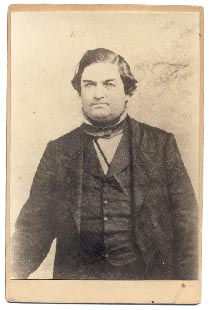 Following an election that was held in July at the St. Louis Exchange on 2nd Street, a city council was organized in Sacramento City. Those elected to the city council were John P. Rodgers, H. E. Robinson, P. B. Cornwall, William Stout, E. F. Gillespie, Thomas F. Chapman, Michael T. McClelland, Albert M. Winn and B. Jennings. William Stout was made president but A.M. Winn was soon made president after Stout left the city. Winn’s first major task was adopting a city charter that was rejected by election on September 20. A charter was eventually adopted in October. Winn served as president of the city council until Hardin Bigelow was elected mayor in February 1850.
Following an election that was held in July at the St. Louis Exchange on 2nd Street, a city council was organized in Sacramento City. Those elected to the city council were John P. Rodgers, H. E. Robinson, P. B. Cornwall, William Stout, E. F. Gillespie, Thomas F. Chapman, Michael T. McClelland, Albert M. Winn and B. Jennings. William Stout was made president but A.M. Winn was soon made president after Stout left the city. Winn’s first major task was adopting a city charter that was rejected by election on September 20. A charter was eventually adopted in October. Winn served as president of the city council until Hardin Bigelow was elected mayor in February 1850.
August 2, 1846
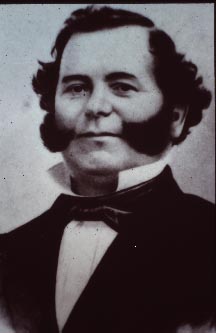 Mariano Guadalupe Vallejo was released from prison at Sutter’s Fort by Commodore Robert F. Stockton’s orders. Captain Montgomery sent an order for Vallejo’s release a week prior but Edward Kern, commander of Sutter’s Fort at the time, refused the orders. Vallejo had been imprisoned since June 16, 1846 after men involved in the Bear Flag Revolt brought him to Sutter’s Fort. The other men that were initially brought to the Fort from Sonoma during the revolt were not released until August 8. Vallejo contracted malaria during his time in prison and spent the next three months in bed.
Mariano Guadalupe Vallejo was released from prison at Sutter’s Fort by Commodore Robert F. Stockton’s orders. Captain Montgomery sent an order for Vallejo’s release a week prior but Edward Kern, commander of Sutter’s Fort at the time, refused the orders. Vallejo had been imprisoned since June 16, 1846 after men involved in the Bear Flag Revolt brought him to Sutter’s Fort. The other men that were initially brought to the Fort from Sonoma during the revolt were not released until August 8. Vallejo contracted malaria during his time in prison and spent the next three months in bed.
August 2, 1852
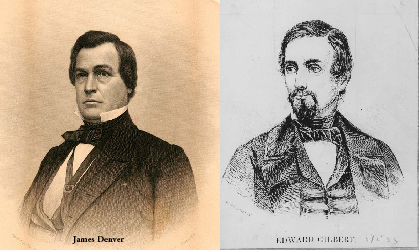 On this day in 1852, State Senator James Denver killed Alta California newspaper editor Edward Gilbert in a duel near the Oak Grove House, which is believed to be located within the present-day Haggin Oaks Golf Course. Gilbert had criticized Governor John Bigler in the newspaper for “grandstanding” while helping a caravan try to rescue immigrants stranded in the Sierra. Denver was the leader of that caravan and took offense to Gilbert’s criticism of Bigler. The two exchanged insults until Gilbert challenged Denver to a duel on August 2nd. Neither had met in person prior and sixty witnesses showed up to see the duel. As the challenged party, Denver chose Wesson Rifles at 40 paces.
On this day in 1852, State Senator James Denver killed Alta California newspaper editor Edward Gilbert in a duel near the Oak Grove House, which is believed to be located within the present-day Haggin Oaks Golf Course. Gilbert had criticized Governor John Bigler in the newspaper for “grandstanding” while helping a caravan try to rescue immigrants stranded in the Sierra. Denver was the leader of that caravan and took offense to Gilbert’s criticism of Bigler. The two exchanged insults until Gilbert challenged Denver to a duel on August 2nd. Neither had met in person prior and sixty witnesses showed up to see the duel. As the challenged party, Denver chose Wesson Rifles at 40 paces.
Both missed on the first round. Gilbert was not a good shot and Denver shot at the ground as he tried to call off the duel. Gilbert refused to end the duel and was shot in the abdomen in the second round, dying within 5 minutes. James Denver was later appointed Secretary of State of California and in 1854 he was elected to Congress. In 1857, Denver was appointed Governor of the Kansas Territory and the city of Denver, CO is named after him. He was a brigadier general in the Civil War. After all his success in politics, the duel was a stain on his career. James Denver lost three chances at nomination for the Democratic Party to the presidency in 1876, 1880, and 1884 because popular sentiment had shifted over dueling as an archaic custom of the past.
August 3, 1847
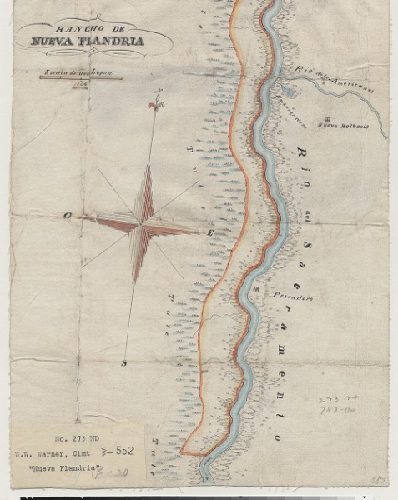 On this day in 1847, John Sutter wrote in the New Helvetia Diary, the daily logbook kept at Sutter’s Fort, “McDowell Gunsmith moved this day with his family on the [opposite] side of the Embarcadero, to establish himself there.” James and Margaret McDowell travelled overland to California in 1845, and James worked at Sutter’s Fort as a gunsmith.
On this day in 1847, John Sutter wrote in the New Helvetia Diary, the daily logbook kept at Sutter’s Fort, “McDowell Gunsmith moved this day with his family on the [opposite] side of the Embarcadero, to establish himself there.” James and Margaret McDowell travelled overland to California in 1845, and James worked at Sutter’s Fort as a gunsmith.
The McDowell family lived in a log house built directly across the river from present-day Old Sacramento after James purchased 600 acres, at 12.5 cents per acre, of the Rancho Nueva Flandria land grant from John Schwartz. In May 1849, James McDowell was killed in a saloon fight and was one of the first individuals to be buried in the New Helvetia Cemetery. As a way of supporting herself and her children, Margaret McDowell hired a land surveyor to survey 160 acres of her property into 41 blocks. She named the town Washington, later known as the Broderick in West Sacramento.
Image of the Rancho Nueva Flandria land grant, courtesy of the Bancroft Library.
August 4, 1852
The Sacramento Valley Railroad was incorporated. Construction did not begin until February 1855. Theodore Judah was hired in May 1854 and Lieutenant William Tecumseh Sherman became the Vice President in August 1855.
August 12, 1839
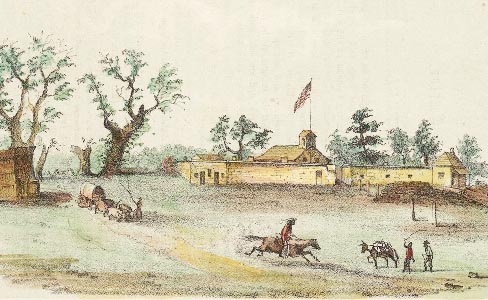 John Sutter arrived at the confluence of the Sacramento and American Rivers aboard the ship Isabella captained by William Heath Davis. Men on board noticed debris in the branches of the trees and noted the area flooded often. The group traveled up the American River until much of the crew found the mosquitoes unbearable and a fear from Natives from the nearby village were forming on the bank. Fearing mutiny, Davis left Sutter and his small landing party at what is today B and 28th Street in Sacramento. Sutter’s landing party consisted of three sailors, ten Hawaiians that journeyed with him since Hawaii, and a large bulldog. Sutter fired a salute from three small cannons as Davis left back towards the Sacramento River. After giving gifts to the local village, Sutter expressed his plans to build a settlement in the area.
John Sutter arrived at the confluence of the Sacramento and American Rivers aboard the ship Isabella captained by William Heath Davis. Men on board noticed debris in the branches of the trees and noted the area flooded often. The group traveled up the American River until much of the crew found the mosquitoes unbearable and a fear from Natives from the nearby village were forming on the bank. Fearing mutiny, Davis left Sutter and his small landing party at what is today B and 28th Street in Sacramento. Sutter’s landing party consisted of three sailors, ten Hawaiians that journeyed with him since Hawaii, and a large bulldog. Sutter fired a salute from three small cannons as Davis left back towards the Sacramento River. After giving gifts to the local village, Sutter expressed his plans to build a settlement in the area.
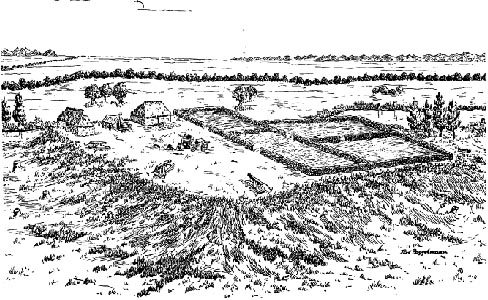 The natives brought Sutter to a high knoll about a mile south of Sutter’s landing, the location where Sutter’s Fort is today. This was the beginning of a permanent European American presence in the Sacramento Valley. Sutter named his new home Nueva Helvetia, which means New Switzerland. Sutter lived in a canvas tent and the Hawaiians built grass huts while a couple adobe structures were being built followed by the Central Building that was built a year later.
The natives brought Sutter to a high knoll about a mile south of Sutter’s landing, the location where Sutter’s Fort is today. This was the beginning of a permanent European American presence in the Sacramento Valley. Sutter named his new home Nueva Helvetia, which means New Switzerland. Sutter lived in a canvas tent and the Hawaiians built grass huts while a couple adobe structures were being built followed by the Central Building that was built a year later.
Artist conception of Nueva Helvetia in 1839 before the Fort was built as shown Sacramento Historical Society’s Golden Notes Fall 1987.
August 14, 1850
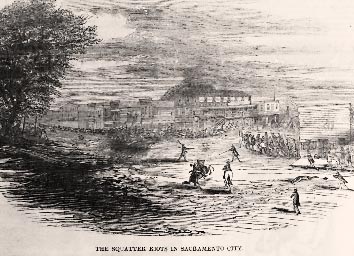 Newcomers to the city were displeased by John Sutter’s land claims and the speculators who bought land from Sutter. Many squatted on land near the city as there was no affordable lodging and they believed the ownership of the land was not legitimate. On this day, Charles Robinson and Joseph Maloney organized a militia of about forty squatters and marched through Sacramento City in response to the court’s writ of restitution to seize the property that squatter John T. Madden was unlawfully occupying. The squatters were confronted at the corner of 4th and J Street by Mayor Hardin Bigelow and his fellow settlers. Bigelow ordered the squatters to relinquish their firearms but shots were fired instead. Hardin Bigelow was wounded along with Charles Robinson. The city’s first assessor, J.W. Woodward, was among those killed along with Joseph Maloney, Jesse Morgan, and two civilians. Sacramento’s first sheriff, Joseph McKinney, was killed the next day while attempting to break up a squatter camp near Brighton. The Squatters’ Riot wound down soon after.
Newcomers to the city were displeased by John Sutter’s land claims and the speculators who bought land from Sutter. Many squatted on land near the city as there was no affordable lodging and they believed the ownership of the land was not legitimate. On this day, Charles Robinson and Joseph Maloney organized a militia of about forty squatters and marched through Sacramento City in response to the court’s writ of restitution to seize the property that squatter John T. Madden was unlawfully occupying. The squatters were confronted at the corner of 4th and J Street by Mayor Hardin Bigelow and his fellow settlers. Bigelow ordered the squatters to relinquish their firearms but shots were fired instead. Hardin Bigelow was wounded along with Charles Robinson. The city’s first assessor, J.W. Woodward, was among those killed along with Joseph Maloney, Jesse Morgan, and two civilians. Sacramento’s first sheriff, Joseph McKinney, was killed the next day while attempting to break up a squatter camp near Brighton. The Squatters’ Riot wound down soon after.
Robert Semple and Walter Colton resurrected an old printing press and published the first edition of the Californian newspaper. This was the first newspaper published in California. The newspaper was published weekly until November 1848.
August 17, 1849
The first steamboat brought around Cape Horn to California arrived at Sacramento City. The steamer George Washington operated regular service between Sacramento City and San Francisco until November 1849 when it sank.
August 23, 1841
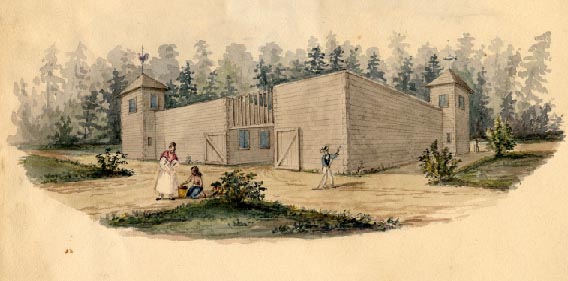 Captain Ringgold of the Wilkes Exploring Expedition, the first U.S. Navy expedition to explore the Pacific coast, visited New Helvetia. Ringgold took note of the development of John Sutter’s establishment and the ongoing construction of what would become Sutter’s Fort.
Captain Ringgold of the Wilkes Exploring Expedition, the first U.S. Navy expedition to explore the Pacific coast, visited New Helvetia. Ringgold took note of the development of John Sutter’s establishment and the ongoing construction of what would become Sutter’s Fort.
Because Sutter discussed with Ringgold that he was, at the time, about to purchase Fort Ross from the Russian American Company, Ringgold’s artist that accompanied him, Titian Ramsay Peale, drew what he thought the future Sutter’s Fort would look like using elements of the Russian fort. Drawing courtesy of the American Philosophical Society.
August 27, 1847
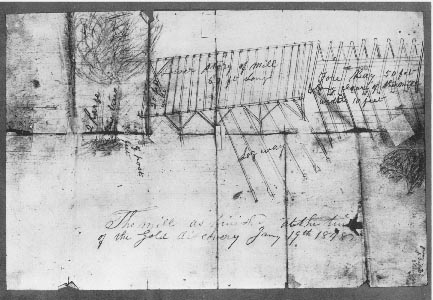 John Sutter writes in the New Helvetia Diary, the daily logbook at Sutter’s Fort, “Made a contract and entered in partnership with Marshall for a sawmill to be built on the [American] fork.” John Bidwell, Sutter’s head clerk, stated in his memoirs, “I wrote the contract between [Marshall] and Sutter to build the mill. Sutter was to furnish the means; Marshall was to build and run the mill, and have a share of the lumber for his compensation.” Construction of the sawmill began shortly after the contract. Using local California Indian labor and former soldiers of the Mormon Battalion, Marshall and Sutter’s sawmill was built in the Cullumah Valley on the south fork of the American River. James Marshall discovered gold at the mill on January 24, 1848.
John Sutter writes in the New Helvetia Diary, the daily logbook at Sutter’s Fort, “Made a contract and entered in partnership with Marshall for a sawmill to be built on the [American] fork.” John Bidwell, Sutter’s head clerk, stated in his memoirs, “I wrote the contract between [Marshall] and Sutter to build the mill. Sutter was to furnish the means; Marshall was to build and run the mill, and have a share of the lumber for his compensation.” Construction of the sawmill began shortly after the contract. Using local California Indian labor and former soldiers of the Mormon Battalion, Marshall and Sutter’s sawmill was built in the Cullumah Valley on the south fork of the American River. James Marshall discovered gold at the mill on January 24, 1848.
James W. Marshall’s drawing of the lower portion of the mill structure and the forebay. (Courtesy of the California State Library)
August 31, 1851
The “Flying Cloud” clipper ship arrived in San Francisco. The clipper left New York on June 2nd and arrived in San Francisco in 89 days and 21 hours later setting a world record. Although Josiah Perkins Creesy is credited with captaining the ship, his wife Eleanor Creesy helped chart the voyage. The clipper beat its own record 3 years later, but the record was not broken until 1989.
This Day in History, July
July 31, 1846
 On this day in 1846, Sam Brannan arrived in Yerba Buena (now San Francisco) aboard the ship the Brooklyn. Brannan, a 26-year-old elder in the Mormon Church, brought over 200 Mormon voyagers to California looking for a place for freedom of worship. The Brooklyn left New York on February 4, 1846, traveled around Cape Horn, and stopped at Hawaii before arriving in California. In June 1846, while in Hawaii, Brannan met with Commodore Robert Stockton and learned of the U.S. Navy’s plans to seize Monterey, the capital of Mexican California. Brannan hoped that when his pioneers arrived in Yerba Buena, they would be the ones to capture the small port town. When they arrived on July 31, much to Brannan’s dismay, the U.S. flag was already flying over the presidio.
On this day in 1846, Sam Brannan arrived in Yerba Buena (now San Francisco) aboard the ship the Brooklyn. Brannan, a 26-year-old elder in the Mormon Church, brought over 200 Mormon voyagers to California looking for a place for freedom of worship. The Brooklyn left New York on February 4, 1846, traveled around Cape Horn, and stopped at Hawaii before arriving in California. In June 1846, while in Hawaii, Brannan met with Commodore Robert Stockton and learned of the U.S. Navy’s plans to seize Monterey, the capital of Mexican California. Brannan hoped that when his pioneers arrived in Yerba Buena, they would be the ones to capture the small port town. When they arrived on July 31, much to Brannan’s dismay, the U.S. flag was already flying over the presidio.
Sam Brannan brought with him aboard the ship an old printing press that he used to publish the California Star newspaper starting in January 1847. In the fall 1847, Brannan opened a trade store outside Sutter’s Fort. It was at his trade store in February 1848, that a teamster from Sutter’s sawmill tried to buy alcohol using gold found at the mill. Brannan announced the gold discovery in May 1848 and sold mining equipment at inflated prices. He is one of Sacramento’s founders and California’s first millionaire.
July 31, 1854
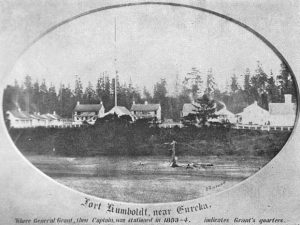 On this day in 1854, Captain Ulysses S. Grant resigned from his post at Fort Humboldt without explanation. Grant never recorded the reason for his resignation, but growing friction between himself and Colonel Robert Buchanan, largely due to his intemperance, brought about a fear of being court martialed. Moreover, his missed his family and reunited with them in St. Louis. Grant did not serve in the army again until the Civil War. Grant served at Fort Humboldt, in what is today Eureka, for just over 6 months.
On this day in 1854, Captain Ulysses S. Grant resigned from his post at Fort Humboldt without explanation. Grant never recorded the reason for his resignation, but growing friction between himself and Colonel Robert Buchanan, largely due to his intemperance, brought about a fear of being court martialed. Moreover, his missed his family and reunited with them in St. Louis. Grant did not serve in the army again until the Civil War. Grant served at Fort Humboldt, in what is today Eureka, for just over 6 months.
